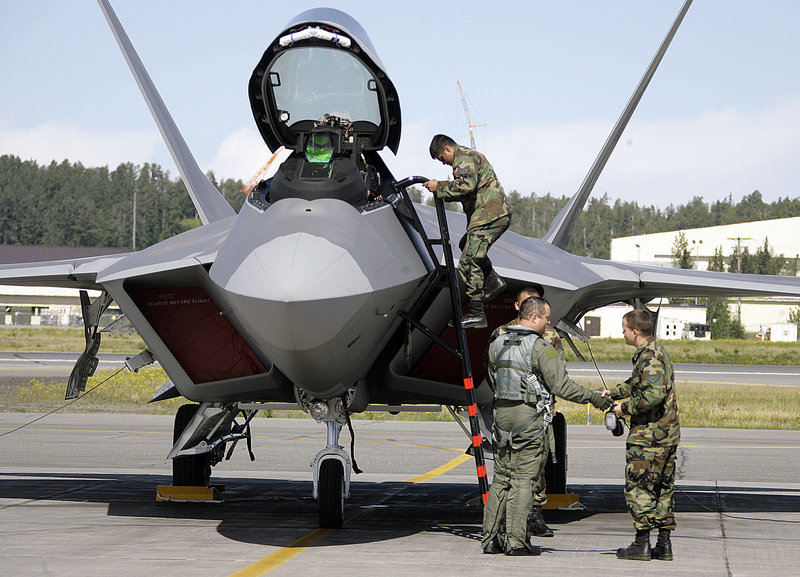Capt. Jeff “Bong” Haney was headed back to base in his F-22 Raptor fighter jet, ripping through the frigid Alaskan night beyond the speed of sound at more than 1,000 mph, when things started going terribly wrong.
Packed tight in cold-weather gear to protect him from the bitter temperatures, the Air Force pilot pulled back on the control stick at about 38,400 feet to gain altitude. Then Haney saw his plane was beginning to fail him.
A caution light glowed green through his night vision goggles, alerting him that a section of the aircraft was overheating. Almost instantly, the F-22’s onboard computers detected an air leak in the engine bay and began automatic shutdown of various systems, including the main oxygen supply.
Gasping for air, Haney set the throttles to idle and began lowering the plane to the snow-covered valley below. About 35 seconds later, the plane began to roll upside down. He couldn’t recover. There, amid the Talkeetna Mountains north of Anchorage, the 31-year-old Haney crashed and died.
The crash was another grim episode for the controversial F-22. It has been in service since 2005, yet never called into combat despite conflicts in Iraq, Afghanistan and Libya. The military’s most expensive fighter jet, made by Lockheed Martin Corp., has continued to experience equipment problems — notably with its oxygen systems.
New details from an Air Force report last week drew attention to the November 2010 crash and raised questions about the F-22 and the way the Air Force has dealt with the oxygen issue.
Even before the fatal Alaska crash, there were numerous complaints from pilots that the jet’s oxygen systems weren’t feeding them enough air, which caused wooziness in flight. Because of this, the entire fleet of F-22s was grounded for nearly five months beginning in May. But even after the grounding was lifted, investigators still had no answers for why the malfunctions occurred.
Since mid-September when the order was lifted, the Air Force said, there have been 14 episodes in which pilots have experienced “physiological incidents” that may have been caused by a lack of oxygen.
The Air Force has spent months addressing issues with the oxygen system with inspections, additional training and enhanced protective gear. The Air Force also has a scientific advisory board and a safety investigation board studying the oxygen issues. The study was initially scheduled to conclude by November but now is expected to be finalized this winter.
“We continue to implement improvements to the aircraft’s life-support systems and are carefully collecting and analyzing operational, maintenance and physiological data for all Raptor flights,” said Maj. Chad Steffey, an Air Force spokesman.
Experts had hoped that a yearlong investigation into the Alaska crash would provide new insights into the problems with the oxygen system. Instead, the Air Force concluded that Haney, one of its top pilots, was to blame because he was too distracted by his inability to breathe and should have engaged the F-22’s emergency oxygen system.
Last week’s report generated much debate over whether the Air Force turned Haney, an experienced and award-winning aviator, into a scapegoat to escape more criticism of the F-22.
Haney “most likely experienced a sense similar to suffocation,” the report said. “This was likely (Haney’s) first experience under such physiological duress.”
To save himself and the plane, Haney should have leaned over and with a gloved hand pulled a silver-dollar-size green ring that was under his seat by his left thigh to engage the emergency system, the report said.
It takes 40 pounds of pull to engage the emergency system. That’s a tall order for a man who has gone nearly a minute without a breath of air, speeding faster than sound, while wearing bulky weather gear, said Michael Barr, a former Air Force fighter pilot and former accident investigation officer.
“It would’ve taken superhuman efforts on the pilot’s behalf to save that aircraft,” he said. “The initial cause of this accident was a malfunction with the aircraft — not the pilot.”
Barr said the Air Force blamed Haney because the brass doesn’t want more criticism of the F-22 program, which will cost an estimated $77 billion and whose need was called into question even before its first test flight.
“They’ve taken all the heat they want to,” Barr said. “They paid a lot of money for an aircraft that doesn’t work.”
While every other warplane in the U.S. arsenal has been used to pummel targets in Iraq, Afghanistan and Libya, the Air Force’s F-22s have sat idle — used only in test missions. Even so, F-22 pilots have experienced seven major crashes with two deaths, including Haney.
According to the Air Force, each of the sleek, diamond-winged aircraft cost $143 million. Counting upgrades, research and development costs, the federal Government Accountability Office estimates that each F-22 cost U.S. taxpayers $412 million.
Despite its problems, the plane is considered the most advanced fighter jet in the world. It has state-of-the-art engines with thrust-vectoring nozzles that can move up and down, making it exceptionally agile.
An F-22 can reach supersonic speeds without using afterburners, enabling it to fly faster and farther. It’s also packed with cutting-edge radar and sensors, allowing a pilot to identify, track and shoot an enemy aircraft before that craft can detect the F-22. The Air Force says the aircraft is essential to maintain air dominance around the world.
Two decades ago, during the Cold War, the U.S. government planned to buy 648 of the fighters for $139 million apiece to battle enemy fighter jets in dogfights. But the government’s order was repeatedly slashed until 2009, when then-Defense Secretary Robert Gates ended the purchase at 188 planes, the last of which has rolled off Lockheed’s assembly lines in Marietta, Ga.
Lockheed declined to comment for this article.
Send questions/comments to the editors.



Comments are no longer available on this story